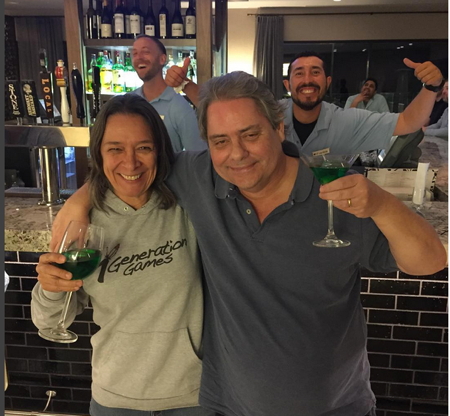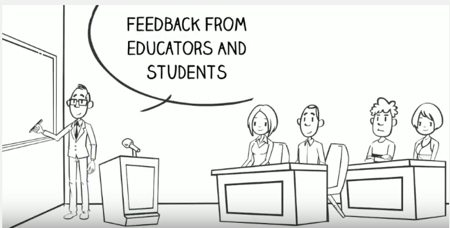I went to the Computer Users in Education conference in Palm Springs last month, not knowing what to expect. It turned out to be way cooler than what you’d expect and I definitely intend to go back for more reasons than I can tell you in just one post.

One of my favorite sessions was sponsored by a commercial vendor
http://www.discoveryeducation.
Disclaimer: I have exactly zero to do with this company and had, in fact, never heard of them before this session.
The session did really fun way of presenting they called “smack down strategies” . Different resources are discussed by each of the two presenters and then they had an instant Twitter poll on which people like best. There are two ideas I stole, um, adopted, from that presentation and here is the first one.
At my presentation , which you can download here, I talked about how we include teachers and students in every step of our game design. Or you can watch a one minute video here.
My story, and I’m sticking to it, is that asking for input when a game is nearly done isn’t asking for advice it is asking for approval, because at that point it is really time-consuming and expensive to make changes. We solicit input from students, teachers and parents all along the way.
So …. I thought I would put these two ideas together and put up a link to an activity just getting started, The Giant’s House
At this point in the game, the player is hearing a story from Aunt Jean about how the Ojibwe people got the dog. In the middle of this level, they are in the giant’s house and finding objects. As you can see, we just have the very basics and very shortly the objects are going to be hidden far better as I re-do this scene. Here are some modifications we are considering:
- Clicking on the item gives the name for it in Ojibwe or in Spanish
- Clicking on the item gives a short story about it – this could be anything, e.g. Corn can grow an inch a day in the summer and if you stand in a cornfield when it is really quiet you can hear it growing
- Clicking on some items could play a video about it, like the coup stick
- You can do a math problem to “buy” a hint, which is something you will need once we hide the items really well.
- Any other suggestions we get from teachers, students or others who play our games.
Right now, everything runs fine on either desktop/ laptop computers or iPads except for the movie when you win, which does not run on iPad because autoplay is disabled. That’s a simple fix, so I will get that done this week.
Out of the four suggestions I gave, let me know which ones you like best in the comments and I will add those this week. Then, we’ll do it again next week with the suggestions we get and pick the top two of those.
UPDATE: You can see the first revisions of the Giant House activity here.


Suggestion 2! It’s an interesting math fact with so much potential. Students could estimate how much the corn will grow in x amount of time and if they’re getting frustrated, there could be an option for them to just listen to the corn grow 😛 (or ask for a hint, or something. But maybe not inside the giant’s house :P)
1 is a neat technique for ambient learning. 4 is a truly excellent idea, I would gladly have done math problems on Pottermore rather than find annoyingly hidden objects. Information from 3 is more likely to stick than information from 1, but it would be fun to have the names of things in only Ojibwe or Spanish and then try and recall them at a later point in the game. Get students used to surprise quizzes 😛
But ultimately, my favorite is 2 cause it’s a really cool ‘math fact’ like Benford’s law or Xeno’s paradox and brings out the interestingness of math to people who might not be naturally interested.
I like suggestion #4, where the student can work a math problem to buy a hint. I think on those problems, it would be good to have the teacher feedback on tested students. I also like suggestion #1, where student clicks on item and gets name in Ojibwe or Spanish. I think having the language in there is another great way to help people get smarter. I think the items videos are a cool idea, but I feel having just one hidden video a level would be good, like on coup stick. The videos get exciting, and its easy to have too many where a person gets confused. Also, having video on key item is a great bridge to other parts of game. You could always have the game where the students, after video, take the coup stick to their elders for another level. I loved the photo! Its great seeing you together! Keep up the good work! Proud of all of you.
#4. I like the idea of having a chance to get more help to offset frustration that could come with game play. My niece loves the games but hates math but she has to do the math to play the games. This gives her an appreciation for math and now she hates it a little less. I think in cases like that, it would be beneficial to have a little bit of a brain break.
I like options 2 and 4 the best.
I like 2 and 4 🙂